
Why are tennis scores so peculiar? Nobody seems to know the answer, although there are several theories.
Tennis has a very illogical scoring system. Both players start on zero, which is called love. From there, the points go to 15, then 30, then 40. If a player on 40 scores one more point, they win that game. If the other player manages to score 40 as well, so both players are tied on 40, it is called deuce. The next player to score has an advantage, but doesn’t win the game yet. They have to score one more point, so they score twice before the other player can score to win. If the other player scores first, they go back to deuce. There are six of these games in a set and a set has to be won by two games, so, 6-4, for example. If both players get to six games, then it continues until one player has won two more games than the other. Then a player usually has to win the best of three sets to win the match. It’s a little complicated. So, why have these rules evolved? Let’s look at it in sections. Why love? Why 15, 30, 40? Why deuce? Why advantage? Why do you have to win more than two games or sets?
A lot of the theories are based on the French language, which makes sense because tennis began in France in the 12th century. It was played by monks and it was played with the hand. It was called “Jeu de Paume”, which means game of the palm. Later on, people started to use gloves, because it probably hurt, and then rackets had been introduced by the 16th century. The game spread across Europe, but its French origins could have given rise to some of the scoring words.
When players have zero points in tennis, it is said to be love. One theory behind the origin of this word is that it comes from the French word for egg, which is l’oeuf. It is thought that an egg looks like a zero. This could make sense because we use egg to mean zero in English sometimes as well. In cricket, the term “out for a duck” means out for zero points and duck is shortened from duck’s egg. Americans use goose egg to mean zero as well. However, there is no evidence that the French ever used l’oeuf to mean zero in tennis. Also, the pronunciation doesn’t fit. When the word boeuf was brought into English, it became beef. Presumably, l’oeuf would have become leef. Another idea is that love came from the Dutch word “lof”, which meant honor. Playing the game of tennis is for honor and getting zero doesn’t matter. There is also a third idea that love is not a loanword from any other language, but really does mean love. As with honor, you are playing the game for love.
What about 15, 30, and 40? Nobody knows. Here is the most popular theory. In the early days of tennis, the scores might have been kept on 2 adjacent clocks. At the start of the game, the hand was on 12 for zero. When somebody scored, the hand was moved to 15, then 30, then 45, When the hand got to 60 again, they would have won. 45 could have become 40 due to the way people speak: forty five, forty fi, fortyf, forty. There are no other sports that are scored in this way, but it is a believable explanation. The problem with this explanation, though, is that most clocks didn’t start counting minutes until 1690. Up until then, only the hours were counted. So, the scoring system would have been 3, 6, 9. There were some clocks that had minutes, but not a lot. The best explanation I have found is that the scoring comes from the original game, jeu de paume. The court was 90 feet long and each time someone scored they moved 15 feet closer. They moved 15 feet, 30 feet, 45 feet.
Deuce is probably the easiest to guess at. In French, deux is two. In old French it was deus, and when tennis was invented, it was deuce. Deuce means two because the two players are tied on the same score.
The advantage idea comes because it is fairer than having someone win by one point if the two players have an equal score. It takes luck out of it and makes the game better. There is one explanation that goes back to the clock. When the scoring system was changed to 15, 30, 40, it left 20 minutes on the clock. If both players are on 40, then there are two tens to get to 60. If a player scores a point, the hand moves to 50, then 60 if they score again. If they don’t score, it moves back to 40. That makes sense, but it relies on the clock explanation for the points being true. It seems that no one actually knows the reasons, but it makes tennis a very interesting game. And this is what I learned today.
Photo by Gonzalo Facello: https://www.pexels.com/photo/close-up-photo-of-person-holding-tennis-racket-and-ball-1432039/
Sources
https://time.com/5040182/tennis-scoring-system-history/
https://www.usta.com/en/home/improve/tips-and-instruction/national/tennis-scoring-rules.html
https://en.wikipedia.org/wiki/History_of_tennis
https://www.tennistheme.com/tennishistory.html
https://www.bbc.co.uk/bitesize/articles/zvdfxyc
https://www.quora.com/Why-do-umpires-in-the-French-Open-say-zero-instead-of-loeuf
https://thetennisbros.com/tennis-tips/rules/why-is-tennis-scored-the-way-it-is/
https://en.wikipedia.org/wiki/Tennis_scoring_system#Game_scoring_origins
